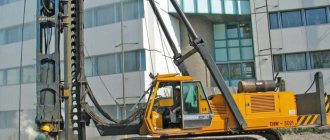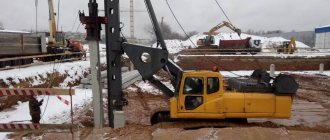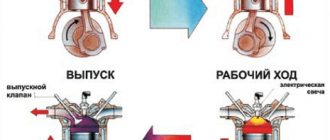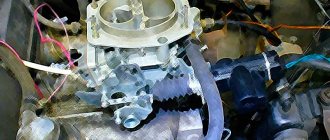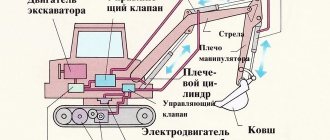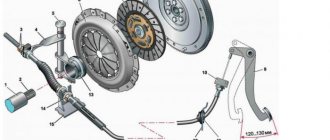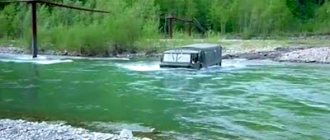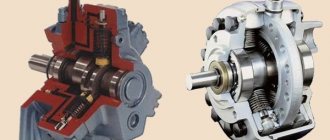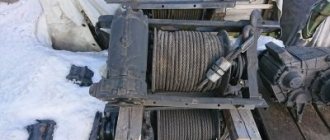If during construction there is a need for piling work, along with other equipment the contractor will definitely need a pile driver. What it is?
Drive hammers, piling hammers or diesel hammers for piling work are one of the necessary types of construction equipment when constructing pile foundations and other operations, such as constructing pits or driving pipes. This technology is used in various situations: on complex and water-logged soils, to reduce the cost of materials and construction work, during construction in populated areas and near other buildings and structures, etc.
Driving piles with a diesel hammer also allows you to carry out work in conditions of moving soil, temperature changes and soil freezing, dynamic changes in groundwater levels, etc. Pile foundations are an almost universal technology that can be used to solve a variety of problems!
But not only the professionalism of the builders, but also the quality of the equipment used plays a big role in how high-quality, reliable and durable the foundation turns out to be. The efficiency of every device and piece of equipment is important: from surveying tools to pile drivers and hammers.
The latter are used at the final stage of work for direct immersion of piles; the final quality of the pile foundation largely depends on their serviceability and efficiency.
Driving piles with a diesel hammer
Our company carries out work on driving and driving piles in small and medium volumes using high-speed equipment.
You can find out in more detail when the use of pile driving machines is justified. Call us and we will help you with driving piles. And now we will talk about diesel hammers, which are used on piling equipment, including our piling equipment. The classification of impact equipment used in piling work is carried out based on its design features, according to which diesel hammers of the tubular and rod type are distinguished.
Piling hammers are also divided into groups based on the mass of the impact part. Hammers with a hammer weight are distinguished:
1. Rod.
You can see rod-type devices in image 1.1:
Rice. 1.1Diesel rod hammer for piling work
The design of a diesel rod hammer consists of the following main elements:
The piston block is a monolithic structure cast inside the hammer body. It includes the piston itself and compression rings, a fuel supply hose, a nozzle for spraying the fuel mixture and a pump that drives it.
The piston block is fixedly fixed on a hinged support, from the bottom wall of which two guide rods extend.
Rice. 1.2 Diesel rod hammer SP-7
The rods, for more rigid fixation, are connected at the top by a traverse. During operation, the impact part of the hammer moves along the guide rods, on the lower wall of which there is a chamber for combustion of the fuel mixture.
2. Tubular.
Tubular-type structures are shown in Image 1.3.
Rice. 1.3 Tubular diesel hammers
The tubular diesel hammer consists of the following parts:
Rice. 1.4: Tubular diesel hammer SP-77
You can choose the required piling installation yourself in our equipment section.
Types of piling hammers
It has already been mentioned that compared to hydraulic and steam hammers, diesel devices are used much more often. Such a hammer is essentially a diesel engine mounted on the mast of a piledriver and pushes the impact head along vertical guide rods.
Hammers come in two main varieties: rod (MSDSH and DD) and tubular (MSDT). The rod hammer design uses a cylinder of two rods, while the tubular hammer design uses a fixed pipe.
Nozzles and spare parts
The most common models of hydraulic hammers (as a rule, this applies to the middle class) are equipped with a whole arsenal of attachments, which are made of durable, high-quality steel.
- The lance, which is the most popular attachment. This tool has a cylindrical shape and, unlike a chisel, has a four-sided sharpening. The lance is effective in crushing almost any material.
- Wedge – a cylindrical attachment for a hammer with double-sided sharpening of the working part within 30 degrees. It is used for crushing and splitting various objects and materials.
- A chisel is an attachment much like a wedge. In principle, they are interchangeable elements and, as a rule, are used to perform the same work. The main difference between these two types of tools is the sharpening angle. Taking into account this parameter, a chisel is relevant for softer materials, while a wedge can cope with more complex tasks.
- A tamper is a fairly common and well-deserved tool. The scope of application of this type of nozzle can be determined based on its name. Hammers equipped with rammers are used at the stage of preparing various bases when performing construction and repair work.
- A pile cap designed for driving them into the ground.
Features of use
The hydraulic hammer is an attachment and for its operation it requires a wheeled or tracked installation (pilfer) equipped with an external boom. Wheeled pile drivers are made on the basis of all-wheel drive heavy trucks, while tracked ones are based on excavators, tractors or cranes.
When driving steel and reinforced concrete piles, a cap is used to protect the top of the pile from destruction by a hammer; when driving wooden piles, the head of the pile is protected with a cylindrical ring made of strip steel.
The weight and dimensions of the driven piles are determined by three parameters of the pile driver:
- boom lifting capacity;
- usable mast height;
- hydraulic hammer power.
The functionality of the pile driver depends on the presence of a mechanism for adjusting the tilt and reach of the boom. Universal and semi-universal pile drivers allow you to drive piles at an angle; simple pile drivers have a fixed mast.
A hydraulic hammer is a highly loaded mechanism subject to wear. When purchasing or renting a device, the availability of consumables, their price and repair base are important. If the supplier has been on the sales market for a long time, has a service network and highly qualified specialists, then this will be an advantage when choosing.
Areas of application
As already noted, hydraulic hammers of various modifications have long been used in many industries. First of all, it is worth highlighting the main areas of application.
Carrying out dismantling work of varying complexity, which is the most common area of application of the described working equipment for excavators and other special equipment. Carrying out road repair work. Construction. In this case, we are talking about the misconception according to which hydromorlot is only capable of destroying
It is important to consider that on many construction sites this equipment is used as a piling technique. In addition, the devices are also used for splitting blocks of piles. Earthworks in winter to remove the frozen layer of soil. Hard Rock Mining
Powerful excavators for quarries and used in tunnel construction are equipped with hydraulic hammers.
It is important to note that this is not a complete list of the capabilities of the installations under consideration. So, for example, small-sized models are widely used for forging, that is, as forging equipment
Our company will supply equipment to the site
carries out piling work in strict accordance with the requirements of SNiP and other regulatory documents.
The technology for driving piles is fully described in documents specially developed for the period of piling work: PPR (works project), technological map, etc., during the work a summary sheet of pile driving is maintained. Thus, the process in the full sense is production and its strict execution, especially during pile driving, is monitored by the person responsible for the piling work.
Of course, the construction of a foundation on piles is carried out not only with the use of pile-driving equipment. For example, driving screw piles is carried out by other installations; by the way, our company purchased a new installation (see more details: A new pile-driving installation was put into operation) which allows this type of work to be carried out.
The management of our company exercises strict control over the entire cycle of piling work, so the quality of the work we construct is consistently high. Leave a request and we will contact you.
Mechanisms for driving driven piles
Piling hammer
Reinforced concrete support pillars for foundations are distinguished by high strength, durability and high technical characteristics (the pile is resistant to torsion and bending), however, the installation of a pile field requires many special mechanisms, including machines for delivering supports to the installation site.
The driving process takes place using special pile hammers, which are transported to the construction site using heavy machines and mechanisms: a crawler crane, a cable and hydraulic excavator. Pile supports up to 10 meters long are driven into the ground by special machines - self-propelled pile driving units, which perform the entire technological cycle of lifting, installing, transporting support elements to the installation site, and directly driving support elements into the ground.
The methods for immersing reinforced concrete support rods into the ground differ significantly due to the use of different technologies.
When driving piles, various equipment is used.
Koper
Pile driver
Pile driver - the principle of driving into the ground using a pile driver consists of delivering a series of blows with a hammer to a separate support set in a certain position. Direct driving is carried out using a hammer, which are classified according to the immersion method:
- Diesel hammer - the operation of this equipment is based on the combustion of diesel fuel. The hammer has an impact part - a special piston with a head, when raised to the highest position, the fuel mixture enters the cylinder. When the hammer falls to the lower position, part of the fuel mixture burns in the cylinder. The energy is directed to the pile, as a result of which the support is progressively driven into the ground, then the process is repeated.
- Hydraulic hammer - this equipment operates on a hydraulic drive, which ensures the movement of the striking part of the hammer up and down. The use of hydraulically driven equipment allows you to monitor the force and frequency of impacts that the hydraulic hammer delivers to a separate support.
It is advisable to construct a pile field near an existing residential building using a hydraulic hammer; this will allow the work to be completed in the most gentle manner possible.
As the pile supports are immersed in the ground as a result of hammer blows, part of the soil is displaced to the surface, the rest of the soil is compacted to the sides and downwards from the pile core. The soil compaction zone around individual supports will extend over a distance equal to 2 to 3 times the diameter of the pile core.
A suitable cap is selected for the hammer, which serves to secure individual supports and protect the upper part of the piles from mechanical damage from contact blows of the hammer.
The cap has an internal cavity, which must ideally match the size and configuration of the pile cap. When the machine is driving pile supports, the head helps to evenly distribute the impact over the entire area of the support element. Watch the video of how Koper KG-12M drives piles:
Vibrator
Vibratory pile driver
Vibratory driver - immersion of individual piles into the ground occurs according to a completely different scheme than when using a piledriver. The machines operate on the principle of creating a vibrating moment along the axis of the pile support. A special device is attached to the head, which consists of a rotator and a weight with a shifted center of gravity. The machine is powered by an electric motor or hydraulic drive.
Machines for installing and driving the pile core create vibration, and under the influence of these forces, the necessary conditions are created for driving the shaft into the ground. The operation of a vibratory driver with a head leads to the summation of vertical forces, which, acting on the pile support, help it sink into the ground, ensuring irreversible destruction of the soil structure.
Installations for pressing piles
Pile pressing installation
Pile-pressing installation - machines operate on the principle of smoothly pressing reinforced concrete pile rods in a certain place into the soil thickness. When dense layers of soil are reached, a series of impacts on the piles can be used to immerse the supports to the design marks.
The technology of pressing piles allows you to carry out work near buildings without causing harm or damage to the structures of existing buildings.
Our services for driving reinforced concrete piles
Construction guarantees high-quality performance of any volume of piling work in Moscow and the central part of Russia. We bring to your attention the main advantages of cooperation with our company:
|
|
To order pile driving, you can contact the managers by contact numbers, or use the “Send a request” form, and we will call you back within half an hour.
Main types
First of all, you need to pay attention to the fact that there are several classifications of diesel hammers. It is worth taking a closer look at two of them, as they are the most popular
By type of design
If we consider the classification according to design features, diesel hammers are divided into:
- to tubular;
- rod
The features of these types should be considered separately depending on the selected type.
Rod
The design contains the following elements:
- a piston that stands on a special support;
- vertical guides;
- system for supplying a combustible mixture;
- “cats” that ensure the structure is fixed in the required place.
Upon closer examination of the details, you will notice that the block is a monolithic structure.
It is cast inside the hammer body, and in the block itself, in addition to the piston, there are also compression rings, hoses through which fuel flows, and injectors. The latter are responsible for spraying the mixture into the pump.
The block itself, as already noted, is located on a hinged support. Its lower wall holds vertical guides that ensure the movement of the hammer during the process of driving the pile. To make the structure more rigid, it was decided to connect the guides together with a horizontal crossbar.
When the equipment starts up, the hammer moves along the guides. It moves up and down to drive piles. Additionally, it should be noted that there is a chamber for combustion of fuel liquid at the bottom of the impact housing.
Tubular
The peculiarity of the design of tubular diesel hammers is that it is completely unified and created on the basis of a tractor. In other words, the production of such equipment is carried out according to a proven and established scheme.
Basic design elements.
- "Cats" They are the main equipment for fixing the hammer. The advantage of the device is the presence of an automatic mechanism that ensures timely fixation of the element or its reset.
- Impact piston. Contains compression rings for improved performance.
- Shabota. This is the striking surface that comes into contact with the striker during hammer operation.
- Working part cylinder. It carries out an explosion of the fuel mixture, which ensures the lifting of the hammer.
- Cooling system. Prevents equipment overheating.
- Lubrication system. Provides durability of the structure.
- Guide pipe. It is made of high strength steel.
In this regard, when using equipment of the second type, it becomes necessary to organize regular breaks. This is done so that the structural elements cool naturally. If this is not provided for, the hammer may fail.
By weight
Classification according to the weight of the impact part of the hammer implies the presence of three groups:
- light hammers – up to 600 kg;
- medium hammers – 600-1800 kg;
- heavy hammers - all tools whose mass exceeds 2.5 tons.
The latter are considered the most in demand at any construction site. The former are used for driving small piles in soft soils, as well as for conducting various studies.
Rod type hammer operation
As in the previous case, the work of driving a pile with a hammer of this type takes place in several stages. By the way, the price of a diesel hammer of this type starts from 80 thousand rubles and can reach 1 million rubles or more.
- First, the process of slinging and fixing the pile in the right place takes place. After this, the “cat” is fixed on the winch of the pile driver. Then it goes down and engages with the impact part of the structure.
- The next stage is lifting the cat and the striker to their highest possible position.
- When lifting is completed, the operator activates the release lever. At this moment, the impact part is released and, under its own weight, falls down towards the hinged head, which is fixed to the pile pillar.
- When the firing pin is lowered, the air inside the cylinder is compressed and heated to a temperature of 650 degrees.
- At the moment the hammer hits the hinged head, the pump pumps diesel fuel into the chamber with compressed air.
- During the impact, the fuel spontaneously ignites. The gas that is released at the moment of detonation throws the impact part back upward.
- Naturally, during ascent, the speed will quickly decrease due to the weight of the striker. When the energy is completely exhausted, the part will rush down again. This circular process will continue until the operator switches off the diesel pump.
Models and manufacturers of Russian diesel hammers.
Modern diesel hammers allow high-quality driving of any type of piles in a wide variety of conditions. The main factor in this case is the weight of the hammer itself, since the force of the impacts depends on this, therefore, when marking, the abbreviated name of the type is indicated - rod or tubular and the mass of the impact piston in kg. Thus, all diesel pile driving hammers are abbreviated as MSDS - rod hammers or MSDT - pipe hammers. The main manufacturers of this special equipment in Russia are JSC Stroymash Plant (Sterlitamak, Bashkortostan)
and OJSC "Stroydormash" (Alapaevsk), which produce all basic models, combining them into a series of joint ventures. Each SP hammer is assigned an index indicating its type and purpose, as well as its main characteristics. The higher the index, the more massive piles and in denser soil the diesel hammer can work.
There are models for diesel rod hammers:
- SP-60 - with a shock mass of 240 kg, for piles up to 0.4 tons
- SP-60A - modification of SP-60 with a hammer weight of 250 kg, for piles up to 0.4 tons
- SP-4 - for piles up to 3.2 tons, weight 1250 kg
- SP-5 - 1800 kg, piles up to 3.2 tons
- SP-6V - 2500 kg, piles up to 3.2 tons
- SP-7 - 3000 kg, piles up to 4 tons
- SP-8 - 3500 kg, piles up to 4 tons
For tubular diesel hammers the classification is as follows:
- SP-75A for piles 1.2 - 3 tons
- SP-76A for piles 1.8 - 5 tons
- SP-77A pile weight 2.5 - 6.5 tons
- SP-78A for piles from 3.5 to 8 tons
- SP-79 for piles weighing 5 - 10 tons
Hammers of light, medium and heavy classes are presented here with a mass of impact parts of 1250, 1800, 2500, 3500 and 5000 kg, respectively. In addition, each model has different dimensions, which allows you to work with piles of different heights and thicknesses.
A diesel hammer is a production necessity.
For all possible construction options, diesel hammers are the most profitable alternative to other installations. Purchasing such a unit allows you to avoid many problems and save time. Moreover, the reliability of diesel hammers allows them to be used repeatedly, which will recoup the costs over time. For one-time work, it is more advisable to rent a diesel hammer, choosing the most suitable model.
Pros and cons of the design
Despite some differences between tubular and rod devices, they have common positive and negative qualities. The advantages include the following:
- mobility;
- quite simple and very reliable design;
- energy autonomy;
- The productivity of the machines is quite high.
If we talk about shortcomings, there are only three of them. The first is the ground vibration that occurs when struck by a hammer. During operation, a large amount of dust is created, which makes work difficult. In addition, the detonation of diesel fuel releases a certain amount of harmful substances into the atmosphere, thereby polluting it. The price of a tubular diesel hammer starts at a higher amount - from 320 thousand rubles.
What it is?
Any hydraulic hammer is an additional attachment for special equipment, which, due to its high performance, significantly increases its performance. At the same time, the functioning and impact energy in this case is ensured by the hydraulic system of the excavator, loader and other machines on which the tool is installed. As a rule, the equipment supplied includes a whole set of interchangeable attachments for performing different jobs.
It is worth noting that the described type of attachment began to be actively used back in the days of the Soviet Union. At the same time, its popularity grew, despite the relatively low power of the first models. One of the key advantages of such devices was that their use did not require additional units of specialized equipment
It is important to consider here that the operation of a conventional pneumatic jackhammer requires the presence of a compressor. At the same time, the hydraulic hammer could already be installed on almost any excavator used for other work
As the systems developed, their power rapidly increased, and, consequently, the impact energy
At the same time, the developers paid attention to reducing the size of the equipment
The main parameters of pile hammers are the mass of the impact part, the highest energy of one blow, the highest lifting height of the impact part, and the frequency of blows per minute.
Steam-air hammers are powered by steam or compressed air. There are single-acting hammers, in which the drive energy is used only to lift the striking part, which then makes a working stroke under the influence of its own mass, and double-acting hammers, the drive energy of which also imparts additional acceleration to the striking part during the working stroke, resulting in increased energy impact and the cycle time is reduced.
The impact part of single-action steam-air hammers is a cast-iron body weighing 1250-6000 kg, the guide is a piston with a rod resting on the head of the pile. Such hammers are simple in design, simple and reliable in operation, but due to their low productivity (no more than 30 blows per minute) they are used relatively rarely.
Automatically operating double-acting steam-air hammers with a frequency of blows on the pile of up to 100-300 per minute and a weight of the impact part of up to 2250 kg are more widespread.
The disadvantages of double-acting hammers include a significant mass of stationary parts (“dead” mass), amounting to 60-70% (for single-action hammers up to 30%) of the total weight of the hammer, the ability to drive only light sheet piles, wooden and reinforced concrete piles, high steam consumption or compressed air.
The main components of a double-acting steam-air hammer (Fig. 10.1) are a fixed body, a movable piston with two massive rods (impact part) and an automatic steam distribution device. The hammer body is made up of three cylinders: the middle one - a steam one for the rods. The body is closed at the top with a lid with an eye for lifting and holding the hammer, and at the bottom with an impact plate mounted on the head of the pile. The plate receives impacts from the lower rod of the striking part and can move within small limits along the vertical axis of the body; It is kept from falling out by stops.
The reciprocating movement of the impact part of the hammer is ensured by the alternating supply of steam or compressed air into the upper (above-piston) or lower (under-piston) cavities of the steam cylinder by a spool distribution device. The spool of this device moves in the spool box under the action of steam (compressed air) automatically in such a way that the upper position of the piston always corresponds to the lower position of the spool, and vice versa. By changing the pressure of the supplied steam (compressed air), the hammer impact energy can be adjusted.
Rice. 10.1. Double-acting steam-air hammer
Steam-air hammers are installed on a pile driver or suspended from the hook of a self-propelled crane. They can be used for driving both vertical and inclined piles, as well as for underwater piling work. A significant disadvantage of steam-air hammers is the need to use expensive and bulky compressor units or steam generators, which require additional personnel and vehicles for maintenance and transportation. Therefore, at present, the main means for driving piles are energy-autonomous mobile diesel hammers operating on the principle of a two-stroke diesel engine.
Based on the type of guides for the impact part, diesel hammers are divided into tubular and rod. A tubular diesel hammer has a fixed pipe that guides the striking part in the form of a massive moving piston. In a diesel rod hammer, the guides of the impact part - in the form of a massive movable cylinder - are two rods, fixed at the base of the piston block and connected in its upper part by a traverse. The atomization of diesel fuel in the combustion chamber of rod hammers is atomized, while that of tubular hammers is percussive.
Diesel hammers are suspended from the pile driver using grips and a lifting and dumping device (“cat”), designed to lift and launch the hammer. The “cat” is attached to the winch rope of the pile driver.
Depending on the mass of the striking part, light (up to 600 kg), medium (up to 1800 kg) and heavy (over 2500 kg) diesel hammers are distinguished.
A diesel rod hammer (Fig. 10.2) consists of the following main components: a piston block, a movable working cylinder (impact part), two guide rods, a traverse, a hinged support, a fuel supply mechanism and a “cat” gripper.
Rice. 10.2. Rod diesel hammer
The piston block consists of a cylindrical hollow piston with compression rings and a base. In the center of the piston bottom there is a spray nozzle connected by a fuel line to a high-pressure plunger fuel pump (up to 50 MPa). The pump is powered from the fuel tank. The base of the piston block rests on a hinged support consisting of a spherical foot and a head. The lower ends of the guide rods are fixed in the body of the base, the upper ends of the rods are connected by a traverse. A massive impact cylinder with a spherical combustion chamber in the bottom moves along the rods. A pin (protruding rod) is mounted on the outer surface of the cylinder, driving the fuel pump when the impact part falls down. Raising the striking part to the upper extreme position before putting the hammer into operation is carried out by a movable “cat” gripper suspended from rope 8 of the headframe winch.
When the “cat” is lowered down, the hook automatically engages the roller in the recess of the cylinder casting. The “cat” and the impact part coupled to it are lifted by the headframe winch to the highest position. Then, by manually acting (through a rope) on the release lever, the “cat” and the impact cylinder are disconnected, the latter, under the influence of its own mass, falls down onto the stationary piston. When the cylinder is pushed onto the piston, the air in the inner cavity of the cylinder is compressed (25-28 times) and its temperature rises sharply (up to 600°C). When the cylinder pin is pressed on the fuel pump drive lever, diesel fuel is supplied through the fuel line to the injector and sprayed into the combustion chamber, mixing with hot air. With further downward movement of the cylinder, the hot mixture spontaneously ignites, and at the same instant the cylinder strikes the hinged support, the cap of which is placed on the head of the pile. The expanding combustion products of the mixture (gases) push the shock part upward and exit into the atmosphere. The rising working cylinder quickly loses speed, under the influence of its own weight it begins to fall down again, and the cycle repeats. The diesel hammer operates automatically until the fuel pump is turned off.
The open design of the diesel rod hammer (the piston, internal cavity and guide rods are open during operation) facilitates access of abrasive particles to the rubbing surfaces of the hammer, which contributes to their accelerated wear, which is aggravated by the lack of a lubrication system.
Possessing low impact energy (constituting 25-35% of the potential energy of the impact part), diesel rod hammers are used for driving piles weighing no more than 2000-3000 kg into weak and medium-density soils.
The domestic industry mass-produces rod diesel hammers with impact masses of 240 and 2500 kg, developing impact energy of 3.2 and 65 kJ, respectively, at a blow frequency of 50-55 per minute. Rod diesel hammers are used mainly for driving light reinforced concrete and wooden piles, steel pipes and sheet piles during the construction of protective sheet pile walls of trenches, pits and channels, construction of water intake structures, etc.
Domestic tubular diesel hammers (Fig. 10.3) are made according to a single design scheme and consist of the following main components: impact part - a piston with compression rings, a pipe (cylinder) with a guide and working sections, a shaft (heel), a low-pressure fuel pump and a lifting and dumping device (“cat”). The hammer tube is open at the top and hermetically sealed at the bottom with a chabot with compression rings. The chabot has the ability to move within small limits along the axis of the pipe, thereby achieving complete immobility upon impact. The lower supporting surface of the hammer is equipped with a pin for centering the hammer on the pile.
Inside the cylinder, an elongated piston with a spherical head moves back and forth, shaped to correspond to the recess in the chabot. When the spherical surfaces of the piston and the cylinder are in full contact (at the moment of impact), the annular cavity formed between the walls of the working cylinder and the cylindrical part of the piston at the point where it passes into the spherical head is a combustion chamber. Fuel is supplied to the chabot sphere under a pressure of no more than 3-5 kgf/cm2 (0.3-0.5 MPa) by a low-pressure plunger pump, which is controlled by a falling piston pressing on the drive lever. Fuel is supplied to the pump through flexible rubber hoses from the fuel tank, which is removed from the impact zone and mounted on the cylinder in its middle part. The closed design of the tubular hammer virtually eliminates the entry of abrasive particles into its internal cavities during operation. The cavity of the working cylinder communicates with the atmosphere through suction-exhaust pipes directed upwards.
Rice. 10.3. Sequence of operation of a tubular diesel hammer
To lubricate the rubbing working surfaces of the cylinder and piston, there is an oil reservoir in the upper part of the piston.
Before starting the hammer, the piston is raised by a “cat” suspended on a rope to its highest position, after which the “cat” and the piston are automatically released. When falling freely down the guide tube, the piston presses the drive lever of the fuel pump, which delivers a dose of fuel into the spherical recess of the chabot. With further downward movement, the piston closes the openings of the intake and exhaust pipes and begins to compress the air in the working cylinder, significantly increasing its temperature. At the end of the compression process, the piston head strikes the shaft, which ensures that the pile is immersed in the ground and fuel is sprayed into the annular combustion chamber, where it self-ignites, mixing with hot compressed air. Part of the energy of the expanding combustion products - gases (maximum combustion pressure 7-8 MPa) is transferred to the pile, producing its additional (after a mechanical shock) immersion, and part is spent on throwing the piston up to a height of up to 3 m. Due to the impact on the pile of two blows in succession - mechanical and gas-dynamic - high efficiency of tubular diesel hammers is achieved.
When the piston moves upward, expanding gases as the intake and exhaust pipes 4 open are released into the atmosphere. Fresh air is sucked in through the same pipes as the piston moves further upward. Upon reaching the uppermost position, the piston begins to freely fall down, the working cycle is repeated, and in the future the hammer operates automatically until the pile is completely immersed. Thus, during the first stroke of the operating cycle of a tubular diesel hammer, the cylinder is purged, air is compressed, fuel is injected and sprayed, and during the second, the hot mixture of fuel and air self-ignites and combustion products expand, exhaust gases are exhausted into the atmosphere and sucked into fresh air cylinder.
For normal operation of tubular diesel hammers at elevated ambient temperatures, air or water cooling of the walls of their working cylinders is used. At air temperatures up to 25-30 ° C, hammers with cooling fins on the outer side surface of the cylinder are usually used. at high temperatures (over 30° C) - hammers with a water cooling system in the form of separate vertical sections encircling the side surface of the cylinder and connected in its lower part by an annular tank located at the level of the combustion chamber. When operating at low temperatures, water is drained from the cooling system and air begins to circulate in the system.
In the USSR, tubular diesel hammers with impact weights of 500, 1250, 1800, 2500, 3500 and 5000 kg are commercially produced for driving reinforced concrete piles of all sizes weighing up to 13,000 kg and lengths up to 25 m. Tubular diesel hammers develop an impact energy of 15— 150 kJ at a blow frequency of 43-45 per minute.
The weight of the impact part of the diesel hammer is selected depending on the weight of the driven pile and the type of hammer used. Thus, the mass of the impact part of a rod diesel hammer should be at least 100–125%, and that of a tubular hammer – 40–70% of the mass of the pile immersed in medium-density soil. The jump height of the impact part of diesel hammers is adjusted by changing the amount of fuel injected by the pump, which allows you to change the amount of impact energy depending on the type of piles and soil density.
Tubular hammers are more effective than rod hammers, since with equal mass of the impact part they can drive heavier (two to three times) piles in the same period of time. The low energy performance of diesel rod hammers and their low durability (half that of tubular hammers) are the main reason why the production of such hammers in the USSR is being reduced, and they will be completely replaced by more advanced tubular hammers. A common disadvantage of diesel hammers is the high energy consumption for air compression (50-60%) and therefore the low power spent on driving piles.
The design of tubular diesel hammers is constantly being improved. Currently, high-speed tubular hammers with a pneumatic buffer (pneumatic buffer) have been created, the blow frequency of which is 65-75 per minute.
The pneumatic buffer accumulates energy as the impact part moves upward and imparts additional acceleration to it during downward acceleration. As a result, the power of hammers with a pneumatic buffer and, consequently, the rate of pile penetration is approximately one and a half times higher than that of tubular hammers with a free fall impact part. Domestic diesel hammers with a pneumatic buffer are similar in design, have a mass of the impact part of 500, 1250, 1800 kg, and develop impact energy of 8.5, 19 and 27 kJ, respectively.
Our country has begun serial production of new progressive hydraulic hammers of single and double action, used as replaceable working equipment for single-bucket hydraulic excavators.
Double-acting hydraulic hammers are multi-purpose machines designed for both piling work and loosening frozen soils and rocks, compacting soils, cobblestones and stones when constructing foundations, destroying road asphalt-concrete pavements, etc.
The principle of operation of a double-acting hydraulic hammer is to use the energy of a massive impact part moving at high speed, the acceleration of which occurs under the influence of its own weight and the pressure of the working fluid on its piston. The working fluid is supplied from the pump and accumulator.
The design of a double-acting hydraulic hammer (Fig. X.4) includes the following main components and parts: a working cylinder with a distribution spool and a hydraulic accumulator, a housing with a guide pipe, an impact part and a hammer. The massive impact part is suspended from the piston rod of the working cylinder by means of an elastic hinge.
The operating cycle of a hydraulic hammer consists of accelerating the impact part upward, braking it before the top “dead” point, accelerating downward and hitting the hammer. The impact part does not have areas of steady motion. The hydraulic hammer works as follows. When the pump is turned on, the working fluid flows through the spool into the rod cavity of the working cylinder and into the cavity above the accumulator piston. The shock part begins to accelerate upward. During the lifting of the shock part, the distribution spool is held by a spring in the upper position, liquid from the piston cavity of the working cylinder is forced through the channel through the drain line into the tank, and the accumulator piston moves down, accumulating working fluid. At the end of upward acceleration, piston 6 closes the drain window, as a result of which the pressure in the piston cavity, channel and above the upper end of the spool increases. In this case, the spool moves to the lower position, connecting the piston cavity of the working cylinder with the pressure line. This is followed by a braking phase of the impact part, during which the piston displaces liquid from the cavity into the accumulator.
Rice. 10.4. Double acting hydraulic hammer
After the impact part stops at top dead center, it begins to accelerate downwards under the influence of its own weight and the pressure of the working fluid acting on the piston. When the impact part reaches the speed that it would have at steady motion (for a given pump performance and piston area), the accumulator begins to discharge, releasing the accumulated fluid into the working cylinder, and its piston moves upward. At the end of the downstroke, the striking part strikes the chabot.
Before striking, the upper edge of the piston drops below the check valve, through which liquid from the piston cavity enters the drain line, the pressure in the system drops, and under the action of the spring the spool moves upward. Then the cycle repeats. The air in the guide pipe flows freely into the cavities above and below the striking part through the channel, without providing significant resistance to its movement.
Double-acting hydraulic hammers are equipped with replaceable devices for attaching loosening, crushing and tamping tools.
Domestic hydraulic hammers are characterized by an impact energy of 3.5–120 kJ, a blow frequency of 50–170 per minute and a mass of the impact part of 210–7500 kg. Hydraulic hammers are easy to operate and maintain, have a fairly high efficiency factor (0.55-0.65), and produce low noise during operation.
Differences between piling machines and installations, technical characteristics
According to the autonomy of the basic mechanisms
Pile driving equipment differs from each other according to various indicators:
1. There is a difference in the basic mechanisms that ensure the driving of piles. They can be used in different ways:
a) Mounted or replaceable - hung on load-lifting booms of general construction machines, for example, cranes, excavators, etc. mechanisms have minimal energy dependence on these machines, the base machine only lifts them and moves them to the pile installed at the design point of driving;
b) Semi-mounted - on the base machine several fundamentally different options for attachments can be replaced. For example, the autonomous auger drill, which was used to drill pile leader holes, is removed and a diesel pipe hammer is installed instead, which is used to drive a finished reinforced concrete pile into the leader hole. Or they install an autonomous mechanism, which is used to immerse (screw in) screw piles, etc.
c) Completely dependent on the base machine:
— for work they receive electricity from it;
— a compressor for a pneumatic hammer is mounted on the machine;
— a hydraulic station that ensures the operation of a hydraulic hammer, etc.
By type of pile hammer
Diesel hammers
Pile driving hammers are produced in accordance with GOST R 51041-97.
One of the most common types of pile hammers is the diesel hammer.
This name comes from the operating principle of a diesel engine. In this engine, fuel sprayed into the working cavity is mixed with air and evaporated. The cavity decreases in volume by moving the working piston downward. The air containing fuel vapor is compressed and its temperature rises. It rises to the flash point of the fuel, which ignites and produces hot gases. They push the piston up and along with it, the striking part of the diesel hammer, its “woman,” flies up. At the top point of its trajectory, the exhaust valve hole in the cylinder opens, and the pressure of the burnt gases is released into the atmosphere. The hammer striker begins to fall down. The next portion of diesel fuel is injected into the cylinder cavity and clean air with oxygen is sucked in from outside through the intake valves. In a hot cylinder, a portion of the fuel evaporates, and the piston moves down and compresses the fuel vapor to its flash point. The vapors mixed with oxygen in the air flash and the process repeats. At the moment of the flash, part of the energy of the hot gases pushes the pile down, and the other part of the energy throws the striking part of the diesel hammer - the “baba” - up.
Division of diesel hammers
Diesel hammers are mainly divided into two groups:
1. Tubular or tubular. The hammer cylinder is mounted motionless on the head of the pile, i.e. its upper part. In the cylinder, under the influence of gases from the burnt fuel, a massive metal piston, which is also called a “baba,” is stirred up and down. It moves down under the gravity of the Earth, i.e. under its own weight.
Diesel fuel - diesel fuel - is sprayed in this hammer by impact.
2. Rod. Significant differences from tubular ones are that there are two guide rods that set the coaxiality in the movement of the piston and cylinder. In this case, the piston is stationary, and only the cylinder moves in this design, which is the striking part of such a diesel hammer. In a tubular hammer, the piston is permanently located inside the cylinder. In a rod type, the cylinder is thrown up while the piston is stationary. He climbs the bars to the top point and begins to fall down. In the lower quarter of the movement, the cylinder is mounted on the piston, diesel fuel is injected into it, which is compressed and ignited. The hot gases again push the cylinder upward and the process repeats.
They differ from tubular ones in higher efficiency, simplicity, reliability, and ease of maintenance.
Unit characteristics
If we consider diesel hammer devices, the tubular type is considered more efficient and also has a more advanced design. If you take a hammer of the same weight, tubular and rod type, and compare their efficiency, you will notice that with the same weight, the tubular design allows you to drive heavier piles. The difference in weight can be up to two or three times greater. The main structural parts of these machines are:
- cylinder or rods;
- the striking part, the striker or the head, which moves inside the cylinder;
- chabot, which is the lower part of the hammer to which the head is attached.
Classification of diesel hammers
Driving equipment is divided into types, depending on the design.
By mass of the impact element:
- Lightweight – up to 0.7 t.
- Medium – up to 2.5 tons.
- Heavy - more than 2.5 tons.
By design features:
- Rod rods consist of a piston block, guide elements, a pumping system, and a head clamp. The piston block is cast and is located inside the cylinder. The injection system consists of a nozzle with a hose. The frame guides are located on a hinge plate and connected by a jumper. The striker with the detonation chamber moves along the frame and drives the pile.
- Tubular hammers are distinguished by the fact that the role of a guide is played by a body in the form of a steel pipe. The impact element is a piston into which the fuel mixture is injected.
The hammer body is equipped with forced cooling, unlike rod units. This is an advantage of the design, allowing long-term operation without stopping.
Attachments
The pile driving rig is equipped with pile driver attachments in the form of diesel hammers. They are mounted on the mast guides using a mounting plate. During driving, the hammer moves vertically, descending along with the pile.
Diesel hammers are used in the following production areas:
- Driving piles of different cross-sectional shapes.
- Driving steel sheet piles.
Important! Hammers are fixed on tracked or wheeled installations. The hammer and mast are equipped with universal fastenings, which makes it possible to fix any type of unit.
The cross-section and shape of the sheet piling and piles for a diesel hammer depend on the configuration of the head with which the hammer is attached to the pile shaft. For each type of section, a different head is used. The kit contains a set of such caps for common types of piles.
The process of driving reinforced concrete piles - stages
If we consider the complete process of driving piles, it can be described in several successive stages:
- delivery. Reinforced concrete piles are quite heavy products that need to be brought, unloaded and placed on the construction site in such a way as to minimize their movement during the driving process;
- development of a work plan. Taking into account the location of the pile and the work project, a route for the movement of the pile driver and hammer along the site is developed;
- site preparation. In particular: garbage removal, tree removal, leveling (if required), etc. In some cases, a pit is dug before installing the piles;
- marking the installation site of piles;
- marking the pile. The markings are applied with bright paint in increments of 1000 mm. The presence of marks allows you to control the degree and speed of penetration of the pile into the soil;
- equipment setup;
- driving piles using the selected technology.
Note. During the installation of each pile, the level of its deviation from the vertical axis is monitored. Permissible deviations are contained in the document (“Quality control of the construction of foundations from driven and bored piles”).
What kind of piles are immersed?
Driving piles is the most effective way to drive any type of reinforced concrete piles; all factory-made structures reinforced with a reinforcement cage are suitable for driving using this technology.
Expert advice! The most common reinforced concrete piles in industrial and private construction are structures of solid square cross-section, reinforced with longitudinal-transverse reinforcement with prestressing of the frame. The length of such products varies from 3 to 12 meters, the most popular section is 30*30 and 35*35 cm.
Figure 1.1 : Solid square driven piles
The following types of reinforced concrete piles can also be loaded:
- Square piles with a round cavity are a more economical option for pile pillars; due to the reduction in concrete consumption during production, their price is an order of magnitude lower than that of square piles with a monolithic cross-section, however, the load-bearing characteristics of such products are also lower;
- Round hollow piles - structures with a circular cross-section can have a closed or open lower part; piles with an open tip are filled with soil during the immersion process, which further increases their stability;
Rice. 1.2 : Reinforced concrete piles of circular section
There are other types of piles subject to immersion - these are pillar piles and column piles, but their use has an extremely narrow specialization (hydraulic and road construction), and it makes no sense to consider them as an option for constructing foundations for residential buildings.
Pile vibratory drivers
In the body of this device, 2-4 massive shafts are placed in a horizontal position, which rotate in different directions with equal angular speed. The shafts are unbalanced, but due to the same speed in the horizontal plane, the centrifugal forces are balanced, and horizontal vibrations are practically absent. But the imbalances are fixed in such a way that in the vertical direction these centrifugal forces are summed up. The device and the pile attached to it receive downward vibrations. These vibrations weaken the bonds of soil particles, both among themselves and with the pile. Under the combined force of gravity of the device and the pile, the latter sinks into the ground.
Vibratory hammers are somewhat different from vibratory hammers. In addition to vibrations of the body, they carry out shock actions. The impact is produced by a striker located at the bottom of the device, on the head of the pile. The frequency of these impacts depends on the rotation speed of the shafts and reaches 480 beats/min. Due to the impact action, the vibratory hammer is not rigidly attached to the pile. A vibratory hammer has a higher efficiency than a vibratory driver, since the pile is driven faster as a result of the combination of these two actions.
Both vibratory hammers and vibratory hammers are electric machines.
Tubular diesel hammer
Tubular diesel hammers are available with impact parts weighing from 500 to 2,500 kg. The frequency of blows in them reaches 47-55 per minute.
Tubular diesel hammers use a low-pressure fuel pump, which is used only to meter fuel and supply it to the combustion chamber.
The fuel is sprayed by the impact of the piston head on the spherical cavity of the cylinder heel, where the fuel received from the pump is collected.
The main advantages of tubular hammers compared to rod hammers are:
- the absence of an upper traverse, which eliminates the risk of hammer breakage due to excessive lifting of the striking part, causing an impact on the traverse;
- the presence of a low-pressure pump, more durable and simpler in design and operation; h
- Much better conditions for fuel combustion due to more thorough cleaning of the cylinder from combustion products, carried out by natural ventilation.
Internal combustion hammers also have some disadvantages:
- large dimensions, for example, the length of a tubular diesel hammer with an impact part weighing 2,500 kg reaches 4.5 m, which complicates its operation.
- In addition, diesel hammers require qualified care to avoid operational problems.
In conclusion, it should be said that in very weak soils, diesel hammers do not work well, since the cylinder is thrown up so little that its fall does not provide the air compression necessary for a flammable outbreak in the combustion chamber.
Crawler hydraulic hammer
Used when driving reinforced concrete piles. Reliable operation under all operating conditions and with the simplest maintenance. ROPAT hydraulic pile driving hammers overcome the resistance of heavy bulk or rocky soil and work without stopping on the weakest soil.
In the photo - ROPAT hydraulic pile-driving hammers. Technical characteristics: Impact energy: 38 kNm. The ROPAT hydraulic hammer, mounted on the base of a crawler crane, holds the world record for the frequency of blows: from 70 blows/min. (at maximum amplitude), up to 250 (at min.). Impact power with any impact energy is 1.7 times greater than its analogues. The large impact mass makes it possible to work with a low pre-impact speed, so the seismic effect and noise do not exceed permissible values. Equipped with a double-acting hydraulic motor - it accelerates and lifts the impact mass downward with an acceleration of 1.31 g. Hammer efficiency ─ up to 75%.
The design of the hammer makes it possible to operate it even in dense urban areas and in any climate.
Technical characteristics of diesel hammers
Tubular diesel hammers are rightfully considered the most advanced and efficient designs. With the same hammer weight, they are capable of driving heavier piles (two to three times the difference in the weight of the pile column).
The hammer consists of the following parts:
The spherical recesses on the baba and the chabot, when in contact, form a combustion chamber. Diesel fuel is supplied into it using the injection method, which, when the woman hits the shaft, under the high pressure created in the combustion chamber, self-ignites and throws the woman to the top point. After which the woman’s fall resumes.
Thus, the hammer makes a series of blows on the pile, plunging it into the ground; the process can be clearly seen in the video:
The disadvantages of rod structures also include low durability (the service life, on average, is almost two times less than the service life of tubular hammers).
Diesel rod hammers, due to the limited impact energy, which is 27-30% of the potential energy that the impact hammer can develop, are used exclusively for driving pile pillars into weak, low-density soil.
The most common diesel rod hammers have an impact hammer mass of 2500 and 3000 kilograms; such designs are capable of delivering impact energy up to 43 kJ, while the number of blows per minute is limited to 50-55. We have this equipment: Pile driving equipment.
Rice. 1.5Technical characteristics of different types of diesel hammers
Tubular-type diesel hammers are used for driving reinforced concrete driven piles into any type of soil. If it is necessary to work in permafrost soil conditions, pre-drilled leader wells are used for driving piles.
We recommend looking at photos of the piling equipment in action.
Operating the device
There are spherical recesses on the baba and the chabot, which, when in contact, will form a fuel combustion chamber. Diesel fuel is supplied to this chamber through injection. When a woman hits the chabot, a sufficiently high pressure is created in this chamber, due to which the fuel liquid spontaneously ignites and throws the woman to its highest point. After that she falls back again. In this way, the pile is driven.
If we compare tubular and rod hammers, we can say with confidence that the second type is significantly inferior in terms of service life. The tubular design can last approximately twice as long. Low service life is the main disadvantage of the rod type.
Main types
By type of design
If we consider the classification according to design features, diesel hammers are divided into:
The features of these types should be considered separately depending on the selected type.
Rod
The design contains the following elements:
Upon closer examination of the details, you will notice that the block is a monolithic structure.
It is cast inside the hammer body, and in the block itself, in addition to the piston, there are also compression rings, hoses through which fuel flows, and injectors. The latter are responsible for spraying the mixture into the pump.
The block itself, as already noted, is located on a hinged support. Its lower wall holds vertical guides that ensure the movement of the hammer during the process of driving the pile. To make the structure more rigid, it was decided to connect the guides together with a horizontal crossbar.
When the equipment starts up, the hammer moves along the guides. It moves up and down to drive piles. Additionally, it should be noted that there is a chamber for combustion of fuel liquid at the bottom of the impact housing.
Tubular
Basic design elements.
In this regard, when using equipment of the second type, it becomes necessary to organize regular breaks. This is done so that the structural elements cool naturally. If this is not provided for, the hammer may fail.
Classification according to the weight of the impact part of the hammer implies the presence of three groups:
The latter are considered the most in demand at any construction site. The former are used for driving small piles in soft soils, as well as for conducting various studies.
Technology for driving piles using a tubular device
The sequence of work performed with this type of unit is as follows:
- the first stage is the joining of the piston part with the cat, after which they are raised to the upper position using a pile driver winch;
- after this, this part and the cat are automatically disconnected, as a result of which the impact part falls along the guide;
- While the falling process is taking place, the pump is switched on and begins to gradually pump diesel fuel into a special recess located in the upper part of the chabot body;
- during the lowering of the piston, the process of air compression also occurs inside the hammer tube;
- when the piston hits the shaft, fuel detonates, during which part of the energy is spent on lifting the hammer back, and the other on driving the pile into the ground.
In other words, the immersion and operation of a diesel hammer occurs due to the impact of impact energy and gas-dynamic energy, which occurs during fuel detonation.
How do you drive piles into the soil?
We found that screw and drilled (drilled) rods do not require the use of large construction equipment. But you won’t be able to immerse the driving rods into the ground yourself. A pile driving machine is used for this purpose. It can be tracked or wheeled.
Tracked vehicles will not be able to simply get to the construction site. To transport it, you will need to order a trawl, and this leads to an increase in the cost of the construction process.
Wheeled vehicles are more mobile in this regard, so their use is more economical.
Pile driving technology
Now we will look at the types of construction equipment that are used to drive reinforced concrete piles into the soil.
They differ fundamentally from each other, primarily in the method of immersion:
1.Pile driver
(industrial scale pile driver). The principle of operation of this installation is to apply a series of blows to a pile installed in the required position. The blows themselves are delivered with a hammer, the types of which can also vary:
2.Vibrator
. A machine for installing and driving a pile core, which works on the principle of creating vibrations along the axis of the pile, is significantly different from a pile driver. The machine is powered by a hydraulic drive or electric motor. The device has a rotator and a weight on which the center of gravity is shifted. It is fixed to the head of the pile, and under the weight of vibration it creates all the conditions for immersion of the rod.
3.Pile pressing installation
. This technique is capable of smoothly pressing reinforced concrete rods into the soil. Only at the final stage of immersion is it possible to apply a series of blows to the rods in order for the rods to reach dense layers of soil. This installation is used in cases where construction is carried out near residential buildings or already constructed structures. It avoids damage to buildings as a result of strong shock vibrations.
Piling works
In practice, pile driving work is carried out in the following order:
- The pile driving machine prepares the reinforced concrete core. To do this, the rod is installed in a position in which it will be immersed. That is, the rod is installed in the head of the device.
- The rod is pressed into the ground until it is possible to press it.
- The rod is struck, thanks to which it is recessed to a given depth.
We can conclude that you can independently make a pile-type foundation using bored or screw piles. Or rent a pile driver and purchase a set of reinforced concrete piles. Using special equipment for driving piles will allow you to build a foundation quite efficiently and quickly, the reliability of which will not have to be doubted.
*We never have low-quality pile foundation projects. We fully monitor and implement all design decisions. Our work fully complies with the requirements of the code of design and construction rules, as well as the rules for designing foundations.
Cost of work
| Works (services) | Dynamic driving (immersion) of a single pile | Static indentation (immersion) of a single pile | Dynamic load testing of piles (one test) | Static load testing of piles (one test) | Relocation of construction equipment | Sheet piling fencing for pits | Installation of bored piles |
| unit | linear meters | linear meters | 1 unit | 1 unit | 1 unit | ||
| cost (RUB) including VAT* | from 260 | from 600 | 10 000 | 65 000 | from 90 000 | negotiable | negotiable |
Special equipment for foundation construction
To construct the supporting foundation, a machine is used for transporting and feeding piles and driving piles.
Transportation and installation in a strictly vertical position are carried out using special equipment:
- crane;
- piledriver
It is possible to install piles in a vertical position using both types of equipment. The difference is that the crane can be used in other areas of the construction site, while the pile driver is a highly specialized machine.
The following pile driving machines are used in modern construction:
| Type of equipment | Advantages | Flaws |
| Diesel hammer | Self-contained pile driving machine. Low cost of work, independence from other special equipment, saves time resources. | Very high noise level. |
| Hydraulic hammer | Fuel consumption and sound levels are significantly reduced. | Not independent construction equipment, but an attachment to a pile driver. Cannot move on to another pile until the first one is driven. |
| Vibrator | An attachment whose operation is based on the ability to move the soil apart under the influence of vibration. Allows you to significantly reduce the level of applied force and noise. | A very time-consuming process. |
| Pile pressing installation | The installation includes a small tap for supplying the support, which makes it possible to save on the pile driver. The piles are fed into a central clamp, fixed vertically and pressed into the ground under the influence of enormous force. | Assembly and dismantling of the installation. For installation stability, plumb lines are used. The machine itself has a relatively small mass. |
- impact method;
- indentation;
- vibration. For an example of driving piles, see this video:
- leader drilling.
If the foundation is the basis of a building, then the pile is the basis of the foundation. The quality of the entire construction depends on how high-quality the material is used and how carefully the technology is followed.
If it is necessary to build a structure on problematic soil, the most rational option is a pile foundation. For example, on loose, moving or swampy soil.
Piles are widely used in both individual and industrial construction. And if during the construction of an individual one-story structure it is possible not to use special mechanisms, then the use of special devices and machines on an industrial scale is simply necessary.
